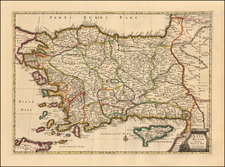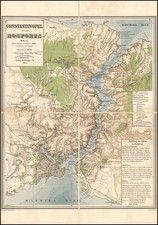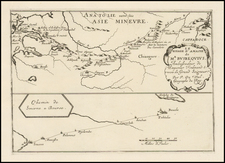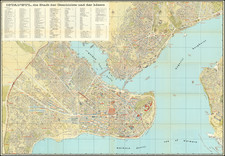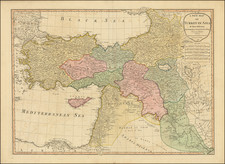Scarce first state of Mercator's map of Asia Minor and Cyprus, from Mercator's edition of Ptolemy's Geographia, first published in 1578.
Includes several Sea Monsters a cartouche and a detailed treatment of the region.
This is from the 1584 second issue of Mercator's Ptolemy, and derives its representation from that ancient geographer.
The intricate strapwork cartouches and archaic geography are hallmarks of the early editions of Mercator's Ptolemy. In later editions, as complex cartouche design fell out of style, they were removed from the plates and replaced with simpler designs.
Gerard Mercator is one of the most famous cartographers of all time. Mercator was born in Flanders and educated at the Catholic University in Leuven. After his graduation in 1532, Mercator worked with Gemma Frisius, a prominent mathematician, and Gaspar a Myrica, a goldsmith and engraver. Together, these men produced globes and scientific instruments, allowing Mercator to hone his skills.
With his wife, Barbara, Mercator had six children: Arnold, Emerentia, Dorothes, Bartholomeus, Rumold, and Catharina. In 1552, Mercator moved to Duisburg from Leuven, where he lived for the rest of his life. In 1564, he was appointed the official cosmographer to the court of Duke Wilhelm of Cleve.
Mercator’s most important contribution was the creation and popularization of a projection which now bears his name. On Mercator projection maps, all parallels and meridians are drawn at right angles to each other, with the distance between the parallels extending towards the poles. This allowed for accurate latitude and longitude calculation and also allowed navigational routes to be drawn using straight lines, a huge advantage for sailors as this allowed them to plot courses without constant recourse to adjusting compass readings.
Mercator’s other enduring contribution to cartography is the term “atlas”, which was first used to describe his collection of maps gathered in one volume. The Mercator atlas was published in 1595, a year after Mercator’s death, thanks to the work of his sons, particularly Rumold, and his grandsons.









![L'Empire Des Turcs, En Europe, En Asie, et En Afrique . . . [includes Cyprus]](https://storage.googleapis.com/raremaps/img/small/71795.jpg)
